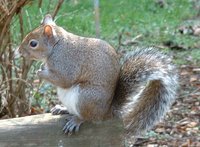Eastern Gray Squirrel
|
|
| Eastern Gray Squirrel | ||||||||||||||
|---|---|---|---|---|---|---|---|---|---|---|---|---|---|---|
 | ||||||||||||||
| Scientific classification | ||||||||||||||
| ||||||||||||||
| Binomial name | ||||||||||||||
| Sciurus carolinensis Gmelin, 1788 |
The Eastern Gray Squirrel (Sciurus carolinensis) is a tree squirrel that is native to the eastern to midwestern United States and the eastern provinces of Canada. The carolinensis name refers to the Carolinas, where they were first recorded by zoologists, and are still extremely common.
The Eastern Gray has also been introduced into a variety of locations on the west coast of North America, including San Francisco and the Peninsula area of San Mateo and Santa Clara counties south of the city. At the turn of the 20th century it was introduced into South Africa and England, spreading across the latter and leading to a reduction in the population of the native Red Squirrel in most parts of England and Wales. It is known in Britain simply as the Grey Squirrel. It has also been introduced to Italy, and the European Union is concerned that the grey squirrel will displace the Red Squirrel from parts of the European continent, as well.
Although the matter is controversial and complex, the main factor in the displacement of Red Squirrels by Grey Squirrels is thought to be competition for resources, leading to a decrease in fitness of the Red Squirrels on all measures (e.g. Wauters, Gurnell, Martinoli & Tosi, 2002). Eastern Grey squirrels tend to be larger and stronger than Red Squirrels and have been shown to have a greater ability to put on fat before the winter. These factors are thought to result in Grey Squirrels competing effectively for a larger share of the available food, resulting in lower survival and breeding rates in Red Squirrels. Parapox virus may also be a strongly contributing factor. Red squirrels are fatally affected by this disease, while Grey Squirrels are unaffected but thought to be carriers. Red Squirrels are also more affected by habitat destruction and fragmentation than the more adaptable Grey Squirrel, which has also contributed to a decrease in their numbers and a linked increase in the numbers of Eastern Grey Squirrels. In Italy, Grey Squirrels have been found to rob the caches of Red Squirrels.
The Eastern Gray Squirrel is common throughout most of its natural range and wherever it has been introduced. It readily becomes tolerant of humans and learns to take food left or offered by picnickers.
As its name suggests, the Eastern Gray Squirrel's fur is predominantly grey, but it can have a reddish tinge. Its belly is white. They have a large bushy tail. Particularly in urban situations where predation risk is reduced, both albino and melanistic forms of the Eastern Gray Squirrel are quite often found. At the northern limits of its range in the Canadian provinces of Ontario and Quebec, the melanistic form tends to be more common than the grey form. There are well established colonies of melanistic (black) individuals in Victoria Park, London, Ontario, Canada (with a daughter colony at Kent State University, Ohio), Albion, Michigan, Washington, DC,and Princeton, New Jersey. Additionally there are colonies of albino (white) individuals in the towns of Exeter, Ontario and Olney, Illinois.
Blacksquirrel.jpeg
GreySquirrel.jpg
Like many members of the family Sciuridae, the Eastern Gray Squirrel is a scatter-hoarder, that is, it hoards food in numerous small caches, for recovery later. Some of these caches (especially those made near the site of a sudden abundance of food) are retrieved within hours or days, for re-burial in a more secure site. Others are not retrieved until months later. It has been estimated that each squirrel makes several thousand caches each season. The squirrels have very accurate spatial memory for the locations of these caches, and use distant and nearby landmarks to retrieve them. Olfaction is used only once the squirrel is within close range (a few centimetres at most) of the cache site.
Eastern_Gray_Squirrel_800.jpg
Predators include hawks, mustelids, skunks, raccoons, snakes and owls. On occasion, this squirrel may lose part of its tail while escaping a predator.
External links
- FCBS Directoy: Eastern Gray Squirrel (http://www.fcps.k12.va.us/StratfordLandingES/Ecology/mpages/eastern_gray_squirrel.htm)
- Squirrel links from London, Ontario (http://www.victoria-park.com/links.htm)
- A brief history of the black squirrel at Kent State University (http://www.registrars.kent.edu/home/SITE_NAVS/history.htm)
- http://www.whitesquirrels.ca/exeter.htm
- Hinterland Who's Who (http://www.hww.ca/hww2.asp?id=89&cid=8)
- An Exotic Evolution: Black Squirrels Imported in Early 1900s Gain Foothold (Washington Post) (http://www.washingtonpost.com/wp-dyn/content/article/2005/05/18/AR2005051802251.html)
References
- Wauters, L. A., Gurnell, J., Martinoli, A., & Tosi, G. (2002). Interspecific competition between native eurasian red squirrels and alien grey squirrels: does resource partitioning occur? Behavioral Ecology and Sociobiology, 52, 332-341.
